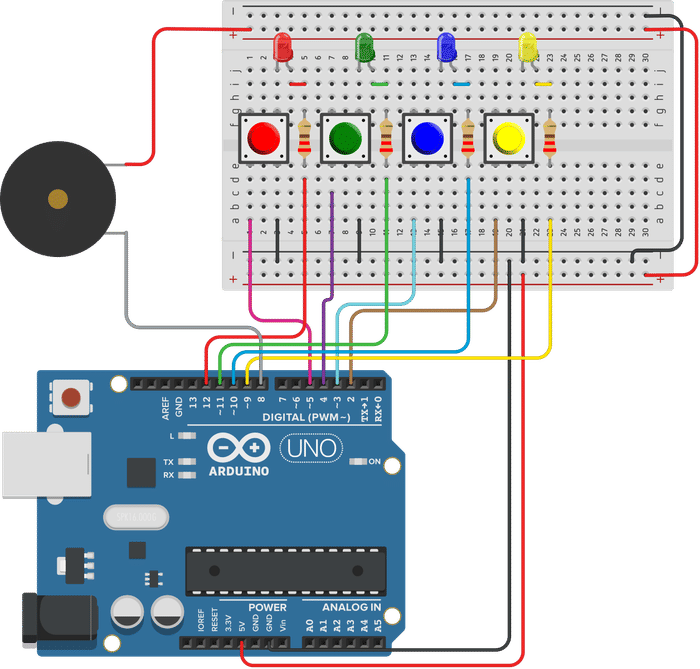Simon Game
Simon is a simple electronic memory game: the user has to repeat a growing sequence of colors. The sequence is displayed by lighting up the LEDs. Each color also has a corresponding tone.
In each turn, the game will play the sequence, and then wait for the user to repeat the sequence by pressing the buttons according to the color sequence. If the user repeated the sequence correctly, the game will play a "leveling-up" sound, add a new color at the end of the sequence, and move to the next turn.
The game continues until the user has made a mistake. Then a game over sound is played, and the game restarts.

Hardware
| Item | Quantity | Notes |
|---|---|---|
| Arduino Uno R3 | 1 | |
| 5mm LED | 4 | Red, Green, Blue, and Yellow |
| 12mm Push button | 4 | Red, Green, Blue, and Yellow |
| Resistor | 4 | 220Ω |
| Piezo Buzzer | 1 |

Diagram

Pin Connections
| Arduino Pin | Device |
|---|---|
| 12 | Red LED |
| 11 | Green LED |
| 10 | Blue LED |
| 9 | Yellow LED |
| 8 | Buzzer |
| 5 | Red Button |
| 4 | Green Button |
| 3 | Blue Button |
| 2 | Yellow Button |
- The LEDs are connected through a 220Ω resistor each.
Source code
simon.ino
/**
Simon Game for Arduino
Copyright (C) 2016, Uri Shaked
Released under the MIT License.
*/
#include "pitches.h"
/* Constants - define pin numbers for LEDs,
buttons and speaker, and also the game tones: */
const byte ledPins[] = {9, 10, 11, 12};
const byte buttonPins[] = {2, 3, 4, 5};
#define SPEAKER_PIN 8
#define MAX_GAME_LENGTH 100
const int gameTones[] = { NOTE_G3, NOTE_C4, NOTE_E4, NOTE_G5};
/* Global variables - store the game state */
byte gameSequence[MAX_GAME_LENGTH] = {0};
byte gameIndex = 0;
/**
Set up the Arduino board and initialize Serial communication
*/
void setup() {
Serial.begin(9600);
for (byte i = 0; i < 4; i++) {
pinMode(ledPins[i], OUTPUT);
pinMode(buttonPins[i], INPUT_PULLUP);
}
pinMode(SPEAKER_PIN, OUTPUT);
// The following line primes the random number generator.
// It assumes pin A0 is floating (disconnected):
randomSeed(analogRead(A0));
}
/**
Lights the given LED and plays a suitable tone
*/
void lightLedAndPlayTone(byte ledIndex) {
digitalWrite(ledPins[ledIndex], HIGH);
tone(SPEAKER_PIN, gameTones[ledIndex]);
delay(300);
digitalWrite(ledPins[ledIndex], LOW);
noTone(SPEAKER_PIN);
}
/**
Plays the current sequence of notes that the user has to repeat
*/
void playSequence() {
for (int i = 0; i < gameIndex; i++) {
byte currentLed = gameSequence[i];
lightLedAndPlayTone(currentLed);
delay(50);
}
}
/**
Waits until the user pressed one of the buttons,
and returns the index of that button
*/
byte readButtons() {
while (true) {
for (byte i = 0; i < 4; i++) {
byte buttonPin = buttonPins[i];
if (digitalRead(buttonPin) == LOW) {
return i;
}
}
delay(1);
}
}
/**
Play the game over sequence, and report the game score
*/
void gameOver() {
Serial.print("Game over! your score: ");
Serial.println(gameIndex - 1);
gameIndex = 0;
delay(200);
// Play a Wah-Wah-Wah-Wah sound
tone(SPEAKER_PIN, NOTE_DS5);
delay(300);
tone(SPEAKER_PIN, NOTE_D5);
delay(300);
tone(SPEAKER_PIN, NOTE_CS5);
delay(300);
for (byte i = 0; i < 10; i++) {
for (int pitch = -10; pitch <= 10; pitch++) {
tone(SPEAKER_PIN, NOTE_C5 + pitch);
delay(5);
}
}
noTone(SPEAKER_PIN);
delay(500);
}
/**
Get the user's input and compare it with the expected sequence.
*/
bool checkUserSequence() {
for (int i = 0; i < gameIndex; i++) {
byte expectedButton = gameSequence[i];
byte actualButton = readButtons();
lightLedAndPlayTone(actualButton);
if (expectedButton != actualButton) {
return false;
}
}
return true;
}
/**
Plays a hooray sound whenever the user finishes a level
*/
void playLevelUpSound() {
tone(SPEAKER_PIN, NOTE_E4);
delay(150);
tone(SPEAKER_PIN, NOTE_G4);
delay(150);
tone(SPEAKER_PIN, NOTE_E5);
delay(150);
tone(SPEAKER_PIN, NOTE_C5);
delay(150);
tone(SPEAKER_PIN, NOTE_D5);
delay(150);
tone(SPEAKER_PIN, NOTE_G5);
delay(150);
noTone(SPEAKER_PIN);
}
/**
The main game loop
*/
void loop() {
// Add a random color to the end of the sequence
gameSequence[gameIndex] = random(0, 4);
gameIndex++;
if (gameIndex >= MAX_GAME_LENGTH) {
gameIndex = MAX_GAME_LENGTH - 1;
}
playSequence();
if (!checkUserSequence()) {
gameOver();
}
delay(300);
if (gameIndex > 0) {
playLevelUpSound();
delay(300);
}
}
pitches.h
/**************************************************
This file defines constants with the frequency
of different musical notes.
*************************************************/
#define NOTE_B0 31
#define NOTE_C1 33
#define NOTE_CS1 35
#define NOTE_D1 37
#define NOTE_DS1 39
#define NOTE_E1 41
#define NOTE_F1 44
#define NOTE_FS1 46
#define NOTE_G1 49
#define NOTE_GS1 52
#define NOTE_A1 55
#define NOTE_AS1 58
#define NOTE_B1 62
#define NOTE_C2 65
#define NOTE_CS2 69
#define NOTE_D2 73
#define NOTE_DS2 78
#define NOTE_E2 82
#define NOTE_F2 87
#define NOTE_FS2 93
#define NOTE_G2 98
#define NOTE_GS2 104
#define NOTE_A2 110
#define NOTE_AS2 117
#define NOTE_B2 123
#define NOTE_C3 131
#define NOTE_CS3 139
#define NOTE_D3 147
#define NOTE_DS3 156
#define NOTE_E3 165
#define NOTE_F3 175
#define NOTE_FS3 185
#define NOTE_G3 196
#define NOTE_GS3 208
#define NOTE_A3 220
#define NOTE_AS3 233
#define NOTE_B3 247
#define NOTE_C4 262
#define NOTE_CS4 277
#define NOTE_D4 294
#define NOTE_DS4 311
#define NOTE_E4 330
#define NOTE_F4 349
#define NOTE_FS4 370
#define NOTE_G4 392
#define NOTE_GS4 415
#define NOTE_A4 440
#define NOTE_AS4 466
#define NOTE_B4 494
#define NOTE_C5 523
#define NOTE_CS5 554
#define NOTE_D5 587
#define NOTE_DS5 622
#define NOTE_E5 659
#define NOTE_F5 698
#define NOTE_FS5 740
#define NOTE_G5 784
#define NOTE_GS5 831
#define NOTE_A5 880
#define NOTE_AS5 932
#define NOTE_B5 988
#define NOTE_C6 1047
#define NOTE_CS6 1109
#define NOTE_D6 1175
#define NOTE_DS6 1245
#define NOTE_E6 1319
#define NOTE_F6 1397
#define NOTE_FS6 1480
#define NOTE_G6 1568
#define NOTE_GS6 1661
#define NOTE_A6 1760
#define NOTE_AS6 1865
#define NOTE_B6 1976
#define NOTE_C7 2093
#define NOTE_CS7 2217
#define NOTE_D7 2349
#define NOTE_DS7 2489
#define NOTE_E7 2637
#define NOTE_F7 2794
#define NOTE_FS7 2960
#define NOTE_G7 3136
#define NOTE_GS7 3322
#define NOTE_A7 3520
#define NOTE_AS7 3729
#define NOTE_B7 3951
#define NOTE_C8 4186
#define NOTE_CS8 4435
#define NOTE_D8 4699
#define NOTE_DS8 4978